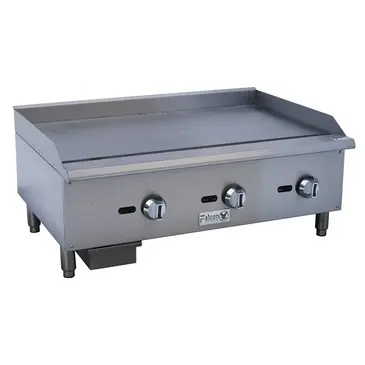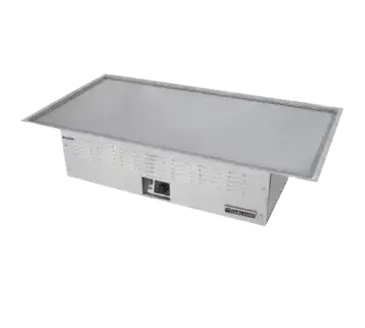Shopping for commercial griddles can be a time-consuming project as there's a variety of sizes, plate thicknesses, utility types, and styles that should be taken into consideration. It is also essential, as Commercial Griddles allow you to apply a heat source to a number of meats, bacon, steaks, and a variety of breakfast items and are an essential piece to any commercial kitchen.
Types of Griddles
Commercial Countertop Griddles

Commercial countertop griddles sit directly on top of a countertop or table. These handy pieces of equipment are desirable for kitchens that don't have a designated spot for a griddle. Because of its mobility, countertop griddles allow you to move it around your kitchen as long as you provide the needed ventilation and utilities. Since these griddles are the least expensive option, they are the most common and are sought after by catering businesses in need of off-site equipment.
Commercial Drop-In Griddles
Commercial drop-in griddles appeal to restaurants in need of saving as much countertop space as possible as they are installed directly into your countertop. Drop-in griddles create a seamless design throughout your kitchen, but installation is labor-intensive and requires a qualified electrician to install. Because of this, drop-in griddles are the most expensive option in commercial griddles.
Teppanyaki griddles

Teppanyaki griddles are a subset of drop-in griddles but have one significant feature that separates itself. These griddles feature a heating element that keeps the center of the griddle hot, whilst the outsides are cooler. This allows you to keep things warm on the outsides of the griddle whilst cooking foods in the center. These types of griddles are primarily found in Japanese restaurants.
What to Look For While Shopping
While figuring out the utility type, heating control style, plate thickness, and ease of use; shopping for commercial griddles can become overwhelming. Griddles are a big investment for any kitchen and saving money upfront means years of harder days in your kitchen. Below is a list of what to look for when shopping for commercial griddles.
Utility (Fuel) Type
Gas Griddles have a heating element under the griddle that heats up as burners are lit. Gas griddles heat up and cool down quicker than electric griddles, featuring more precise temperature control while in use. Generally speaking, gas griddles are cheaper to operate compared to electric but it differs with location.
Electric Griddles have a similar heating technique to gas but use electricity to heat its burners instead of gas. Electric griddles don't need a special hookup to operate, making installation much easier compared to gas.
Heating Control Styles
Thermostatic Heat Control allows you to cook foods at precise temperatures, which is great for more delicate foods such as pancakes and eggs. For that reason, these types of griddles cost more than manual heating griddles.
Manual Heat Control gives you the standard high, medium, and low setting. If you have foods that don't need precise temperatures while cooking, manual controlled griddles are the way to go.
Plate thickness
1/2" Plate Thickness
- Good for delicate items such as pancakes or eggs
3/4" Plate Thickness
1" Plate Thickness
- Good for defrosting food quickly and efficiently.
The Bottom Line
Realize that hard to use griddles slow your kitchen down significantly and you risk serving food late. Spending more now can pay off and save you money and time in the future.
Consider:
- How precise are the controls?
- How Difficult is it to clean?
- Which features does it have that could make the chef's life easier?

